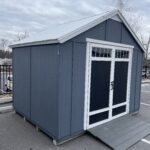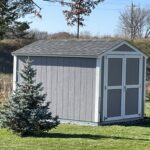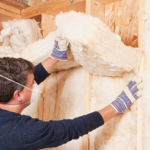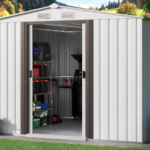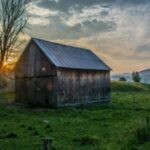Maybe you have a shed on your property and are trying to figure out how much life it has left in it. Or perhaps you want to do some research before putting a new shed up.
One of the major considerations before you buy, or build, a shed, is how long the structure will last. Comparing the life expectancy of different sheds, and the materials used in their construction will give you an idea of how long the one you are planning should last. When estimating the life expectancy of a shed consider the climate where it
Most of you have heard the saying, “You get what you pay for.” When buying sheds remember that saying. If you buy the cheapest structure or the cheapest materials available, the initial cost will be lower, but the shed will not last as long. And if your concern is if you should save a shed, the materials can be a major factor in that determination.
Keep reading and we will help you figure out how which shed will be the best choice for you, your location, your budget, and your expectations. Or, if you already have a shed on your property, learn what factors will make its lifespan shorter or longer.
Steel Sheds
Steel or metal sheds are more cost-effective than wooden sheds, The typical life expectancy for a metal shed is 10 to 30 years. These structures require almost no maintenance, they are strong, and they can be just as attractive as wooden sheds.
The biggest concern you will have with a metal shed is the potential for rust. You also have to consider that the framework under the flooring of the shed is
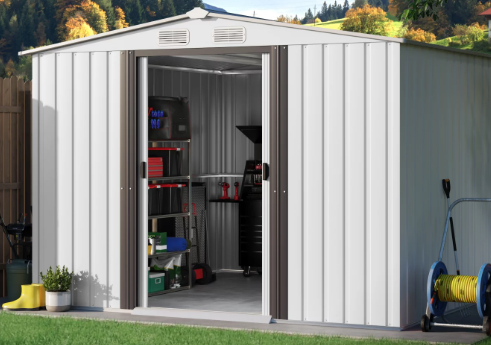
made of wood, so metal sheds are still susceptible to termites. There are a few things you can do to make sure that your metal shed lasts as long as possible.
Tips to make your metal shed last longer
The screws that are used to fasten the metal to the framework are called self-drilling screws. When they are going through the metal they drill a small hole. In this process, tiny pieces of metal are left on top of the metal. Those tiny slivers of metal will rust and they will cause your shed to begin to rust. This problem is easy to fix by sweeping the entire building, the sides, and the roof, to remove all of the metal slivers.
Do not set the shed on the ground without concrete blocks and pads keeping it from making ground contact. If the metal makes contact with the ground it will begin to rust quickly. Also, when you get the blocks in place for your shed use a termite shield to stop those pesky bugs from crawling up the blocks and eating your floor joists or framework.
Clean the shed roof off at least twice a year. Leaf accumulations on top of the roof will hold water and that water will start the rusting process. After you sweep off the leaves, take a few minutes and inspect the screws. If you see rust forming on the screw head or around the screw, then replace that screw ASAP.
When you replace that screw look for a screw that has a larger washer than the one that was previously used. The larger washer will cover any possible damage that is existing from the removal of the previous screw. Another consideration about the screws is the rubber washers, or gaskets will deteriorate over time. If you live in a hot climate they will degrade faster.
Inspect doors and windows to make sure they are sealed and you have no leakage. A little leak around a door or window opening means big trouble over time. Touch the caulking around these openings and check to see if it is cracking, or starting to pull away. If it is then remove the old caulking and replace it with new high-quality silicone caulking.
Keep the building leveled so that doors and windows close properly and the roof sheds water properly. An unlevel building deteriorates much faster than a level one.
Finally, be sure that all screws holding the metal siding or roofing are on snug. If you start to let sheets of metal rattle in the wind, they an soon work their way loose and then you have a much larger problem on your hands.
Wooden Sheds
Wooden sheds often cost more to buy or to build. Many people find the aesthetics of a wooden building to be more pleasing, and some homeowners associations and building codes require property owners to use wooden siding on their sheds and storage buildings.

The average wooden shed will last between 15 and 20 years if it is properly cared for.
Tips to make your wooden shed last longer
Rule #1: You do not want the wood to have ground contact because it causes wood to rot and hinders your yearly inspections for termite damage. Instead, put the building up on concrete blocks and utilize those termite shields.
High-quality paint on the exterior of the building will increase the lifespan of the building by 3 to 5 years. The drawback is you have to repaint when the paint begins to degrade.
Install gutters to prevent the water that sheds from the roof from splashing and splattering on the side of your building. That small amount of water can cause big damage and rapid deterioration of the wooden siding.
A lot of people put air conditioner units in their storage buildings. The water that drips from the air conditioner can cause damage to the siding. Make sure your unit is situated so that it drains properly, and the draining water is not splashing up and hitting the side of your building.
Follow the suggestions for metal buildings. Keep the roof free of leaf matter by sweeping it clean. Keep the gutters cleaned out. Check the roof screws for signs of rusting, and if you have shingles make sure that there are no loose shingles or that the shingles are not starting to harden.
If you are in a cold weather area, take some steps to winterize the shed as well in order to extend its life.
Vinyl Sheds
Vinyl siding on a shed will increase the life expectancy. The vinyl does not need to be painted, it does not rust and it is attractive. The typical vinyl shed will last about 25 years, and many of them last up to 50 years. Spoiler alert: vinyl costs more than wood, usually by hundreds of dollars.

Vinyl does not rust, rot, or mold. It is a good-looking cover and most building codes permit it to be used. Many of the pre-made sheds like Tuff Shed are vinyl.
Tips to make your vinyl shed last longer
If you want that vinyl building to last as long as possible then you have to cover the fascia board. The choices are to paint the board with an exterior grade paint and keep it protected. Of course, that means every few years you will need to paint the board again. The second option is to cover the fascia board in a metal or vinyl trim material that will protect it. Covering the fascia with these materials will create a maintenance-free shed for you.
Build a concrete or gravel pad to place your shed on. These pads protect the structure and lengthen their lifespan. Placing vinyl sheds on concrete blocks is not as good as placing it on a pad, but it is better than placing it on the ground.
When the building is being constructed make sure the roof has felt paper under the shingles or metal, or for the most protection have an ice and snow shield installed.
Plastic Sheds
The plastic sheds do not rust, and they are not prone to termites or water damage that causes them to rot. However, the lifespan of a plastic shed is between 5 and 7 years, depending on the climate the shed is exposed to.
The plastic the sheds are formed out of will start to crack after a few years. This cracking is the result of the plastic expanding and contracting from sun exposure.
There are not many things you can do to increase the lifespan of the plastic shed. It is impossible to keep it out of the sun, and protected from cold and heat. The sheds are inexpensive, and usually very small, so prepare to replace them every few years.
If you notice pieces of a plastic shed working their way loose, rattling, or flopping in the wind, be sure to tighten them up. Keeping all fasteners tight will help ensure that the plastic can withstand high winds, and you never know when that could occur.
Temporary Sheds or Kit Buildings
These are the cheapest sheds on the market. They have a life expectancy of 5 to 10 years, and that is if they are maintained and cared for. There is a reason why these buildings are so much cheaper to buy. Unfortunately, the reason is inferior products, lighter gauge metals, and less structural strength provided by good framing.
The screws are made of a cheap zinc material and they rust faster than the screws used on steel buildings.
The metal on the siding is thin and rusts easily. The thin metal can also be dented and damaged easily because it is not as strong as the materials used on steel buildings or the wood siding on wood buildings.
If you choose one of these buildings, be prepared to replace it within five to ten years.
Conclusion – How Long Does a Shed Last?
The bottom line is that a well-maintained shed of any type should last at least a couple of decades, and that is on the very low end of the range. A shed with proper maintenance and some spot repairs along the way can easily last 40 or 50 years, as long as weather or human-created damage doesn’t compromise the structure.

